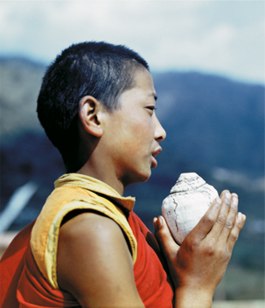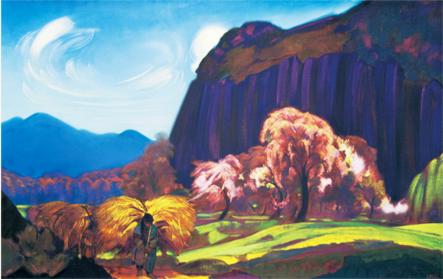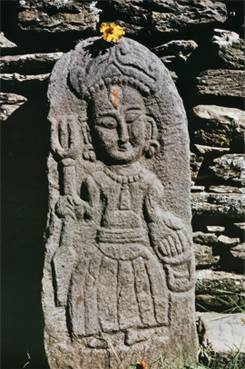The Roerichs lived in India for more than 30 years. They chose this country not by chance. It has always been a country of high culture, spiritually subtle people, and knowledge that has been accumulated and preserved since the most ancient of times. Many people have experienced India’s magnetism. The mystery of its great attraction lies, first of all, in the continuity of its cultural tradition. For the thousands of years of its existence, India has not lost a single people, a single culture. Ancient Egyptians, Sumerians, and other peoples have disappeared from the face of the Earth, leaving behind only material traces of their existence. There is no other country in the world where a multi-century cultural tradition is preserved like in India.
 | |
| The call for the prayer. Photo by L.V.Shposhnikova |
Here in India we see not traces of death, but a live organism, a live body. For many centuries continuously, this culture has been formed, the spiritual image of Indians themselves has developed, precious stones of Indian philosophical thought and wisdom have been polished. Culture and Beauty have created for many centuries this elastic field of powerful and subtle energetics. Fate and the gods desired that there be at least one country on the planet capable of clearly and convincingly demonstrating the evolutionary essence of Culture and Beauty. And it was India that deserved such a great honor. The relationship of Indian culture to the worlds of a different state of matter, the philosophical comprehension of such a relationship, and the ability to take reasonable advantage of it are the distinctive features of this culture. Entering into energetic and informational exchange with India, countries and nations have received from India priceless treasures of Knowledge, true approaches toward the solutions of problems related to the improvement of man, the wise practice of the development of the spirit, and, finally, the cosmic view of the evolution of mankind.
And not without ground, as long ago as in 1913, N. Roerich wrote: “Enticing is the Great Indian way.”[26] Already living in India, he comprehended the boundless character of its culture and spirit, and, the more time that passed, the deeper he plunged into the wisdom and profundity of its centuries of accumulations. “With great joy I notice,” he stated in 1929, “the wide spread of high intellectual and artistic powers in India. Highly gifted individuals are now heading universities, institutes, and schools, and the names of Tagore, Bose, Raman, and other leaders of science and art form a live bridge between the India of today and the deep roots of its past culture.
So, following the greatest achievements, we reach the highest ways.
The great Vivekananda, when asked by his devoted follower what she should do in India, answered: “Love India!”
The great teachings of the Vedas, the behests of Buddha, Apollonius of Tian, Paracelsus, Thomas Vaughn, Ramakrishna, countless calls of centuries and all peoples direct us to the great mountain of India, which protects the treasure.
Love India!”[27]
 | |
| S.N. Roerich. Spring in Kullu. 1939 |
These words “Love India!” were a kind of slogan for the Roerichs. They loved India, lived in India, and created in India, not elsewhere, a unique Institute of Himalayan Studies and called it “Urusvati,” “The Light of the Morning Star.” The institute was the first precious grain of that new science of which the Living Ethics and the Teachers, standing high on the stairs of cosmic evolution, had spoken. Implementing their ideas in life, the Roerichs clearly understood why and in what name it was all done. The new cosmic thinking, the new system of cognition, new science – all this constituted a single whole, calling the planet to climb the ascent to a new stage of cosmic evolution. From the very beginning to the end, everything related to Urusvati was carefully prepared and elaborated by the Roerichs, starting from the Institute’s location, and finishing with the essence of its activities and creative work. It is known that behind this place lies the valley of Kullu in the Indian Himalayas. The Roerichs immediately noticed a very important situation, an accumulation of the high energetics of human thought in this area. The Himalayan slopes, rocks, and caves held invisible accumulations of this thought that had been carried by great personalities, sages, and saints who had been to this valley or had lived there. “The Institute’s location,” N. Roerich noted, “in the ancient valley of Kullu, or Kuluta, was also lucky. Rishis and sages of India had lived in these areas. Many legendary and historical events are related to these uplands. Buddha used to pass through here, and dozens of Buddhist monasteries flourished here in their time. Here, ruins of the Pandavas’ palaces and Arjuna’s cave are located, here Rishi Vyasa put together the Mahabharata. And here is the Viaskund, the place where your wishes come true.”[28]
 | |
| The goddess from the Tripurasundaram temple. Photo by L.V.Shposhnikova |
There were many legends in the valley. The legend of Narasimha, the patron of Kullu, drew N. Roerich’s special attention. “The valley of Kullu,” he wrote, “has its hero-protector – Narasimha, Rajput raja. A beautiful legend is connected with the name of Narasimha. The raja had to escape from Rajputana. Disguised like a modest coolie, the educated ruler escaped to the valley of Kullu. He concealed his personality under the cloak of a simple worker, but his great erudition did not let him remain unnoticed. The light of his justice and knowledge lit all his neighbors. The people guessed that an unusual man had appeared among them, and, of their own will, they began to consider Narasimha as their raja. The ruins of Narasimha’s castle are still standing in Naggar, and the hero’s image is erected under an old deodar. According to legend, Narasimha protects the valley of Kullu. And cursed is the one who will arouse the hero-raja’s justified wrath. They say he visits his country at night in the image of a majestic white-bearded prophet, and many people saw him and were blessed by the ruler. [ . . . ] Now he will protect Urusvati, our Himalayan Reseach institute!
And, above Narasimha’s image, towers the white peak of Guru Guri Dhar, the path of the Spiritual Teacher.”[29]
One of Roerich’s paintings is Guru Guri Dhar. It shows the Teacher, who had close bonds with the Roerichs and participated in the creation of the Living Ethics. Called Mahatma, Great Soul, he once lived in Kullu, and passed through it many times. He left behind legends based on the historical reality of the Great Teacher. The thought energetics of the Great Teacher are sensed in the ancient valley, which still attracts pilgrims and those who have visited it at least once. The thoughts of our great compatriots, the Roerichs, also left behind traces. In ancient times, in order to build a temple, an experienced and knowing priest who could orient well in subtle energetics chose a special place. And the perception of such energetics did not only allow the performance of some religious rituals, but also created for those praying the necessary mood, which helped them to comprehend the spiritual, invisible phenomena. As a rule, a temple’s location is beautiful. Exceptionally beautiful is the valley of Kullu, where the Institute of Himalayan studies is situated. There, the energetics of Beauty merge with the subtle energetics of great and lofty thoughts, which result in the appearance of a special creative field, which the scientists of the Institute have more than once sensed in their work, and which still shows itself in a special mood and easy breath. “When you see the mineral colors of the mountains, when you study the huge geysers full of various mineral salts, when you see all types of hot springs, you understand the character of the abundance of this part of the world, which is still virgin and has witnessed so many cosmic cataclysms. This place is exactly like this. This is a unique place for scientific studies. Here you sense a feast of knowledge and beauty,[30]” N. Roerich wrote. And more:
“If someone would strive to review throughought history the entire world’s striving for the Himalayas, an extraordinarily significant study would result. Indeed, if, starting with a few thousand years ago, all the attractive powers of these heights were reviewed, it would be truly possible to understand why the Himalayas are called “incomparable.” How many Signs from times immemorial are related to this mountainous country! Even in the darkest epochs of the Middle Ages, even in the most distant countries, people thought of beautiful India, their imaginations culminating, of course, in its mountains, its sacred and mysterious snowy giants.
 | |
| S.N. Roerich. Naggar. Kullu. 1938 |
Let us try to gather in our minds all those most beautiful legends that could be conceived only in the Himalayas. In doing so, first of all, we will be struck by the amazing diversity of these traditions. Of course, this richness would be determined by many fiery strata, would become more luxurious due to the generosity of many millennia, would be crowned with the deeds of the best seekers of truth. This is all true. But these top deeds require surrounding splendor, and what can be more majestic than the unsurpassed mountains, with all their inexpressible radiance, with all their ineffable diversity?”[31]
The Kullu valley itself and the mountains adjacent to it were the sources of all kinds of knowledge. “It was noted,” N. Roerich wrote, “that electrical and magnetic phenomena are especially manifest at these height. The latter secure exceptional possibilities for the study of special currents, and one can imagine what new research could be performed by our great physicist Millican to continue his recent wonderful discoveries.
It is remarkable how all the collected information increases the significance of these areas, where the soil’s fertility is combined with the unusual phenomena of the heights and the heroic historical past.”[32]
This Himalayan region opened the most rich of possibilities for research in botany and zoology, archeology, linguistics, traditional medicine, and a number of completely unexpected trends in science.
|
|
||
|
||